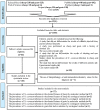The Global Prevalence of Neospora caninum Infection in Sheep and Goats That Had an Abortion and Aborted Fetuses: A Systematic Review and Meta-Analysis
- PMID: 35558895
- PMCID: PMC9090472
- DOI: 10.3389/fvets.2022.870904
The Global Prevalence of Neospora caninum Infection in Sheep and Goats That Had an Abortion and Aborted Fetuses: A Systematic Review and Meta-Analysis
Abstract
Neospora caninum (N. caninum) can be a potential factor causing a significant rate of miscarriages in small ruminants (sheep and goats) worldwide. Therefore, the present study aimed to determine the global status of N. caninum in sheep and goats that had an abortion and aborted fetuses. Five English databases (PubMed, ScienceDirect, Web of Science, Scopus, and ProQuest) were searched for relevant scientific articles published from their inception until November 4, 2021. Finally, 21 studies conducted on sheep (1,671 aborted fetuses and 935 abortive sheep) and 10 studies on goats (130 aborted fetuses and 80 abortive goats) were included for the final meta-analysis. A random-effects meta-analysis model was used to estimate the pooled prevalence with 95% confidence intervals (CIs). Moreover, sensitivity analysis, publication bias test, and quality assessment were performed in this study. The pooled prevalence of N. caninum in aborted fetuses of sheep and goats globally was estimated to be 15% (95% CI: 9-21%) and 7% (95% CI: 2-12%) using molecular methods. Besides, the seroprevalence of N. caninum was estimated to be 17% for aborted fetuses of sheep. The overall prevalence rate of N. caninum infection in sheep that had an abortion was 3%. The present results show a relatively high prevalence of N. caninum infection in sheep that had an abortion and aborted fetuses compared to goats. Therefore, further studies using different diagnostic techniques to more accurately estimate the rate of infection in sheep and goats may help provide adequate control measures and strategies to reduce the rate of abortion in sheep and goats and reduce economic damage to the livestock industry. This study was registered at the International Prospective Register of Systematic Reviews (PROSPERO; code: CRD42020216694).
Keywords: Neospora caninum; abortion; fetus; goat; meta-analysis; sheep.
Copyright © 2022 Nayeri, Sarvi, Moosazadeh and Daryani.
Conflict of interest statement
The authors declare that the research was conducted in the absence of any commercial or financial relationships that could be construed as a potential conflict of interest.
Figures
References
Publication types
LinkOut - more resources
Full Text Sources




